Microsoft Brings Copilot to Office. Does It Work?
Microsoft is going hardcore on bringing AI to its flagship business applications. Is it a useful addition or just another marketing-driven bolt-on?

A couple weeks ago I subscribed to Copilot for Microsoft 365, and I’ve used it enough that I think I can share some insights. Regular readers already know that I’m skeptical of current AI products, and stories about fake law firms sending fake AI DMCA takedowns for fake clients do nothing to change my views.
But that said, AI is here whether we like it or not, and designers are going to have to integrate it into products in a useful, effective ways. And I really do believe that there are plenty of good uses for AI. Building focused systems that are trained on specific data sets and tuned to particular tasks really can be incredibly effective.
When Microsoft announced an integrated Copilot for MS 365 (née Office) it piqued my interest. I wanted to see how they integrated AI into the ubiquitous applications and how well it works. To that end, I do my best to focus on the interactions and functions instead of how well Copilot does its job. It’s difficult to write a piece like this without discussing performance, but I don’t intend this article to be a review.
While I use MS 365 daily and like it fine, I’m not affiliated with Microsoft in any way (aside from giving them my money). I haven’t been asked to write about Copilot and am not being compensated by anyone for this (or any) article.
What Is Copilot for MS 365?
Glad you asked. According to Copilot itself:
Copilot for Microsoft 365 is a new AI-powered writing assistant that helps you write better emails, documents, and presentations. It can suggest relevant content, style, and tone improvements, as well as correct grammar and spelling errors. Copilot can also help you save time by generating summaries, bullet points, and headlines from your text. Copilot integrates with Word, Outlook, and PowerPoint, and learns from your feedback and preferences to provide personalized suggestions.
There are two paid versions of Copilot. Personal and family users can purchase Copilot Pro for $20 per month, which is comparable to paid plans from OpenAI and Anthropic. Business and enterprise customers have to fork out an additional $10 to buy Copilot for Microsoft 365, bringing the monthly price to $30 on top of the MS 365 license. In my case, the Copilot license is more than twice the cost of MS 365 itself.
There are substantial differences between Copilot Pro and Copilot for MS 365. The personal plans basically amount to “faster access to Copilot, with some integrations.” Business plans bring a whole host of features, such as full Office integration (including their new Notion competitor Loop), a separate mode that searches only internal documents in SharePoint and OneDrive, and access to Copilot Studio. Microsoft also claims that business data is “protected,” which means that it is ostensibly kept separate from everyone else’s AI data.
I’m using the business plan and can tell you that signup process is a bit strict. To purchase Copilot for MS 365 I first had to accept a new licensing agreement with stricter cancellation and billing terms. Also, Copilot is only available annually, meaning that businesses commit for an entire year at $360 per seat. There is no “try it out for a month or two and then cancel.”
But that said, Microsoft seems to be very committed to making this work. A live Microsoft rep contacted me within a few days of subscribing and took the time to run through features, understand my use cases, and answer questions. They also have a pretty comprehensive adoption site for businesses, as well as a Copilot Lab for end users.
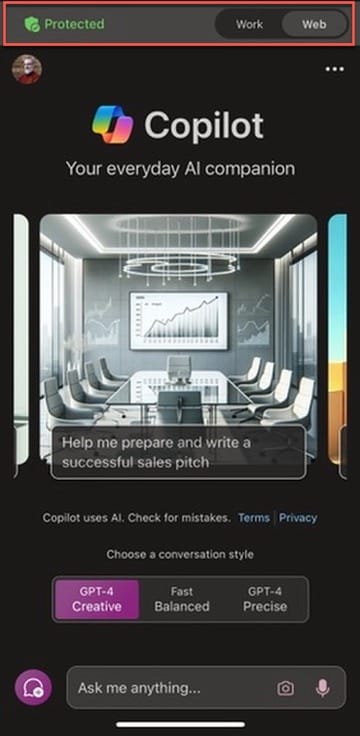
Yeah, but How Does It Work?
Overall, Microsoft has done a nice job of smoothly integrating AI into Office. Most apps offer at least two ways of interacting with Copilot, depending on context. This usually means a discreet Copilot icon in the ribbon (or mobile equivalent), with additional prompts appearing in sensible locations depending on context.
Writing with Copilot in Word
In Word, a prompt appears at the top of a new, empty document. Once you’re underway, a little Copilot icon hangs out at the bottom of the text. The prompt window is easily accessible via a keyboard shortcut or by clicking the in-document icon. From there, you enter your prompt and wait for Copilot to do its thing. Once it’s done generating the response you’re prompted to either “Keep It” or ask something else.
Clicking the icon in the Word navigation bar doesn’t open the writing prompt; instead, it opens a sidebar that allows you to ask questions about the document. One of Copilot’s best features is the list of linked references at the bottom of each response, and the Word version includes this feature as well. In the example below, I asked Copilot to find the contact address in my privacy policy document. Clicking the associated link jumps to the location within the document, which is a very nice feature.
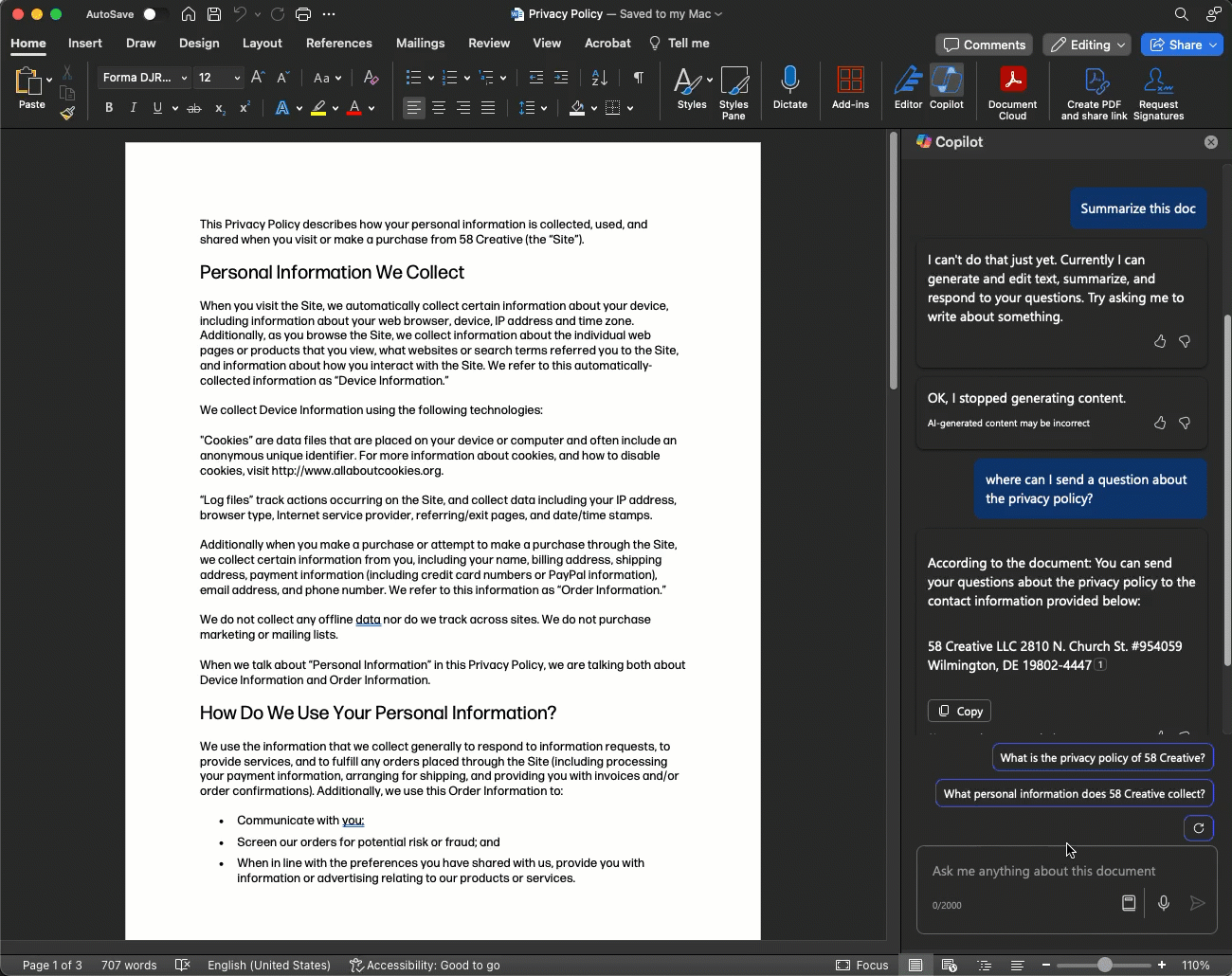
I have yet to try Copilot in Excel but it seems to want to convert everything to a table. Also, I notice that unlike other apps the title includes “Preview,” which implies that it’s still a work in progress. Excel is powerful but can be a real pain to work with, so having a good-quality AI assistant would be a boon.

Loop, Microsoft’s Notion Wannabe
I won’t spend a lot of time discussing Loop, mostly because Copilot behaves much the same as it does in Word. Click the Copilot doodad, write a prompt, get a result. I did notice one neat little feature, which is that the AI keeps track of versions. As a test I asked Copilot to write out a checklist for a social media post, and then asked it to format the content into a table. By clicking in the “Rewrite with Copilot” field I was able to access both versions.

Outlook
Outlook is arguably one of the strongest use cases for AI, and Microsoft provides three features: Summarize, Respond with Copilot, and Coaching by Copilot.
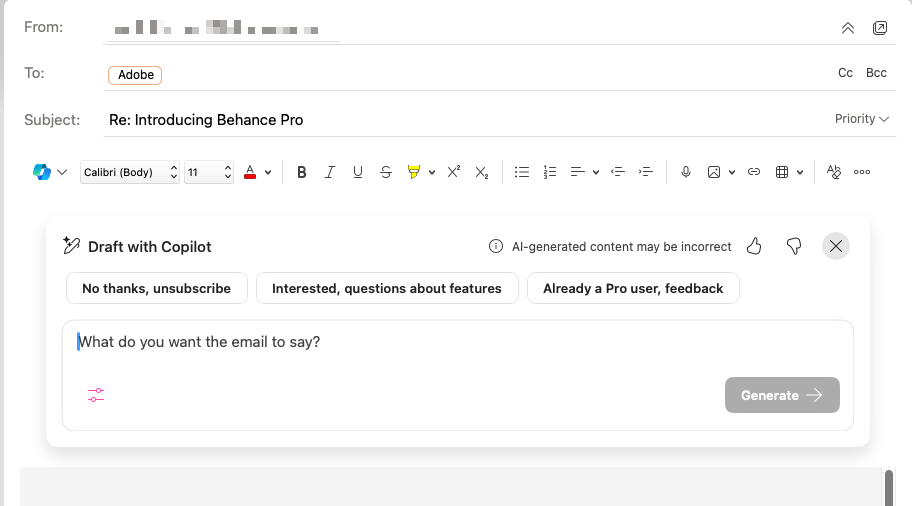
The mobile apps offer the same features as the desktop ones, though Microsoft has chosen a different icon for the summarize feature. I thought this was a little odd at first, but it made more sense once I realized that Outlook uses the Copilot icon for writing assistance. Having two of the same icon for different things in different places could be problematic, especially in a phone-sized interface.
When reading a message, tapping the icon at the top of the app produces a summary.
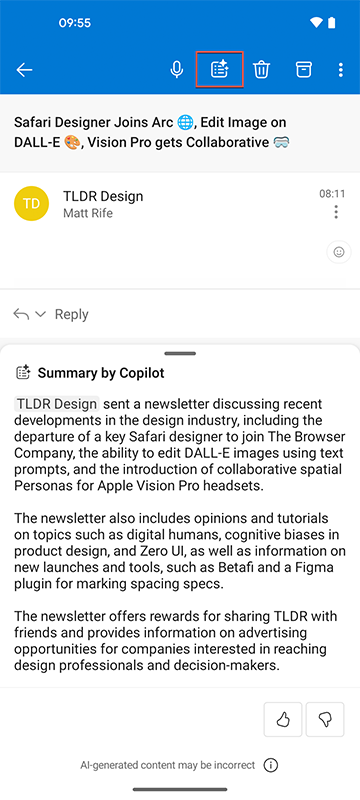
I regularly run the Summarize action on longer emails and it mostly works well, though I sometimes find it’s a little too summarized and lacks important information or details.
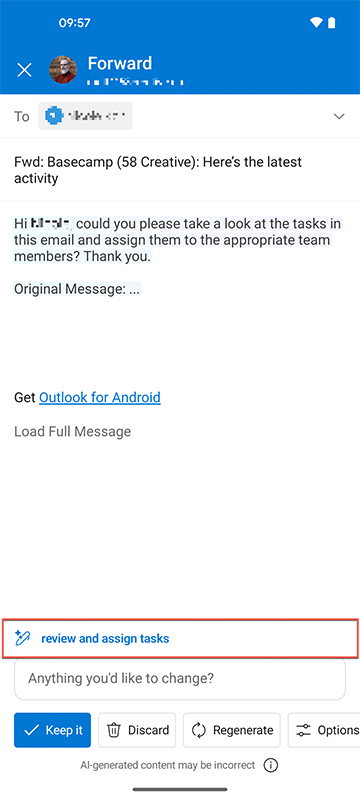
The writing assistance works surprisingly well, at least in my experience. Copilot can either write a message for you or can provide “coaching.” It suggests a few prompts or you can just write your own. If you just want to write your own message without help then simply don’t engage Copilot. Unlike Clippy, Copilot doesn’t nag your or pop up trying to be helpful. (Related: In a cheeky move, Microsoft resurrected Clippy as a Teams sticker pack.)
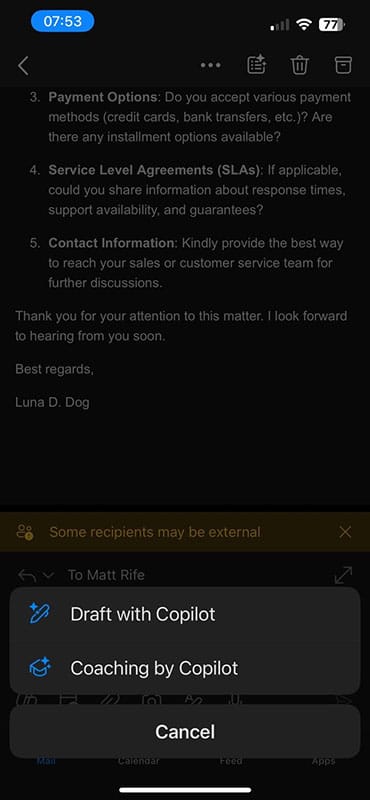
Teams
I don’t use Teams a whole lot on my own, so I can’t delve too far into how well it works, but I may revisit this in the future. But that said, Teams is where Microsoft really kind of goes HAM. This isn’t surprising, given that Teams plugs into everything, including docs, chat, email, calendars, and meetings. In general, I find that Teams can be a little hard to use, largely because it tries to just so damn much. I think that its usability has improved a bit over time, even if its stability is occasionally suspect.
But I think that Copilot can draw on the Hydra-like nature of Teams in some very powerful ways. In addition to finding content in documents and emails, Copilot in Teams is also able to summarize chats and find salient points without requiring the user to scroll back through long threads.
You can also ask Copilot to help prepare for an upcoming meeting and it will attempt to pull together information from the aforementioned sources. I’ve tried this a couple of times without much success, though I suspect that has more to do with the quality of my material than Copilot itself.
Copilot also brings a bunch of features to meetings, including the ability for late joiners to catch up. Microsoft also claims that Copilot can create chapters in recordings based on the speaker and can capture task assignments.
Zoom offers similar meeting features, and I’m looking forward to using them in both products. It’s safe to say that millions of other beleaguered office workers will be overjoyed If these features work as advertised.
What’s Missing
In almost all cases Copilot provides an icon to copy the results, but I would really love the ability to directly send the content to an app. So if I use Copilot to write up something in Loop and want to kick that to an email, I have to copy the content, go to Outlook, open a message, and paste. I would be so much better to click “Send to Outlook” in Loop and skip all the intermediary steps.
Copilot is allegedly available in OneNote, but I have yet to see it in either the apps (Mac, iOS, Android) or in the web. I am going to reach out to my Microsoft rep to see what’s up.
I have thus far found Copilot to be helpful but not earth-shattering. I think that’s partly because having integrated AI is going to require a shift in thinking. I’ve written out my own email responses for 30 years and it’s not natural for me to think of asking a built-in assistant to help.
Trust is another issue. Current-state AIs tend toward "hot mess" territory, and Microsoft subtly acknowledges this by sticking “AI content may be inaccurate” warnings all over the place. So even if I do think to use Copilot for a task, there is still a part of me that thinks, “well, it might do something weird which will take more effort to fix than just doing it myself.”
Closing Thoughts
Overall, I think Microsoft has done a pretty good job in bringing Copilot integration into its flagship office suite. The interaction triggers are nicely integrated into the applications; Copilot is visible but not intrusive and does what it should. The consistency across platforms is great and makes for very smooth transitions when shifting between a computer, tablet, and phone.
These features aren’t going away, designers and product managers need to be thinking about how to bring them into products in a way that’s unobtrusive, helpful, and safe. Simply throwing in a button that’s connected to some rando LLM is most likely going to be a bad solution. Research will be key to understanding how our users interact with our products and what their problems are. From there, we can begin to understand how to use focused AI systems to help.
I keep hearing that AI is going to “free up workers to do more important work,” which mostly seems to be shorthand for “layoffs.” But if built and used properly, high-quality AI does have the potential to make jobs easier while reducing errors. We’re just getting started, and have a long way to go before we know how AI usage is really going to play out.
